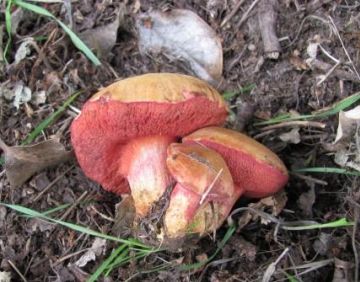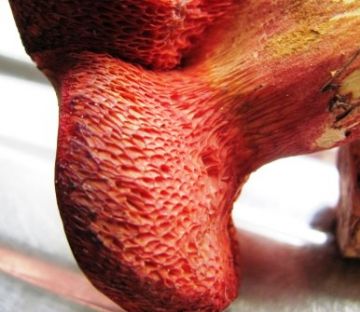The fungi season is gradually gaining momentum in this area and if we can avoid any long spells of dry weather shows promise of being the best for years. A good recent find was Lactarius hysginus, found growing under Corsican Pine at The Hyde Lake, Ingatestone on August 27th. This is a fairly distinctive species - one of those with an extremely viscid cap - but I can find no Essex records either on the BMS Database or in Tony's article on Lactarius in the EN (Vol.24). Unfortunately, no specimens were kept (an oversight) although a full description was taken. It is described as 'seldom reported but apparently widespread' in the Checklist of British Basidiomycota. September 2nd was another good day, a sheltered hedgerow alongside College Wood, Fryerning yielding eight species of Bolete, namely, Boletus appendiculatus, B. reticulatus (over 40), B. edulis, B. luridiformis, B. radicans, Xerocomus subtomentosus, X. cisalpinus and Leccinum carpini - a fine haul and all within a few yards of each other.
Your Forum
This forum has now been more or less replaced by the Club's Facebook page at
The weblog below is for naturalists to use to report interesting sightings, ask questions, report on field meetings and generally post pictures and any information or questions generally relevant in some way to the wildlife and geology of Essex. You will need to register and be logged-on to post to the forum, and you need to upload pictures first, for use in posts. Find out more
The weblog below is for naturalists to use to report interesting sightings, ask questions, report on field meetings and generally post pictures and any information or questions generally relevant in some way to the wildlife and geology of Essex. You will need to register and be logged-on to post to the forum, and you need to upload pictures first, for use in posts. Find out more
|
Mon 6th September 2010 20:27 by Graham Smith Rubinoboletus rubinus at Ingatestone
August 25th : Rubinoboletus rubinus, formerly Chalciporus rubinus (a species that is crying out for an English name!) is an extremely beautiful but scarce member of the Bolete, that is usually found growing under oaks. The small size, pale brown cap, cardamine pores (which are decurrent down the stem) and pale flesh, which turns pink in the cap and bright yellow at the base of the stem, generally serve to identify it. In his article on the Bolete of Essex in EN Vol.19 (2002) Tony Boniface lists records from (inevitably) Epping Forest and also Ian Rose's garden lawn at Mistley (!) while there have been at least four subsequent sightings from Hatfield Forest by Shirley Watson. There is also an earlier record, from Chigwell, in 1986, on the BMS Database. Thus this record appears to be the fifth recorded locality in Essex and is a welcome addition to the fungi of the Writtle Forest and surrounding area. I hope to include the photos in a display on the Bolete of the area at the Club's exhibition in December.
|
Archives: May 2020Aug 2019 Jan 2019 Sep 2018 Jul 2016 Oct 2015 Jul 2015 May 2015 Apr 2015 Mar 2015 Feb 2015 Jan 2015 Dec 2014 Oct 2014 Sep 2014 Aug 2014 Jul 2014 May 2014 Apr 2014 Mar 2014 Feb 2014 Jan 2014 Dec 2013 Nov 2013 Sep 2013 Aug 2013 Jul 2013 Jun 2013 May 2013 Apr 2013 Mar 2013 Feb 2013 Jan 2013 Dec 2012 Nov 2012 Oct 2012 Sep 2012 Aug 2012 Jul 2012 Jun 2012 May 2012 Apr 2012 Mar 2012 Feb 2012 Jan 2012 Dec 2011 Nov 2011 Oct 2011 Sep 2011 Aug 2011 Jul 2011 Jun 2011 May 2011 Apr 2011 Mar 2011 Feb 2011 Jan 2011 Dec 2010 Nov 2010 Oct 2010 Sep 2010 Aug 2010 Jul 2010 Jun 2010 May 2010 Apr 2010 Mar 2010 Feb 2010 Nov 2009 Oct 2009 Aug 2009 Jul 2009 Jun 2009 May 2009 Apr 2009 Mar 2009 Feb 2009 Jan 2009 Nov 2008 Oct 2008 Sep 2008 Aug 2008 Jul 2008 Jun 2008 May 2008 Apr 2008 Mar 2008 Feb 2008 Jan 2008 Dec 2007 Nov 2007 current posts |




















